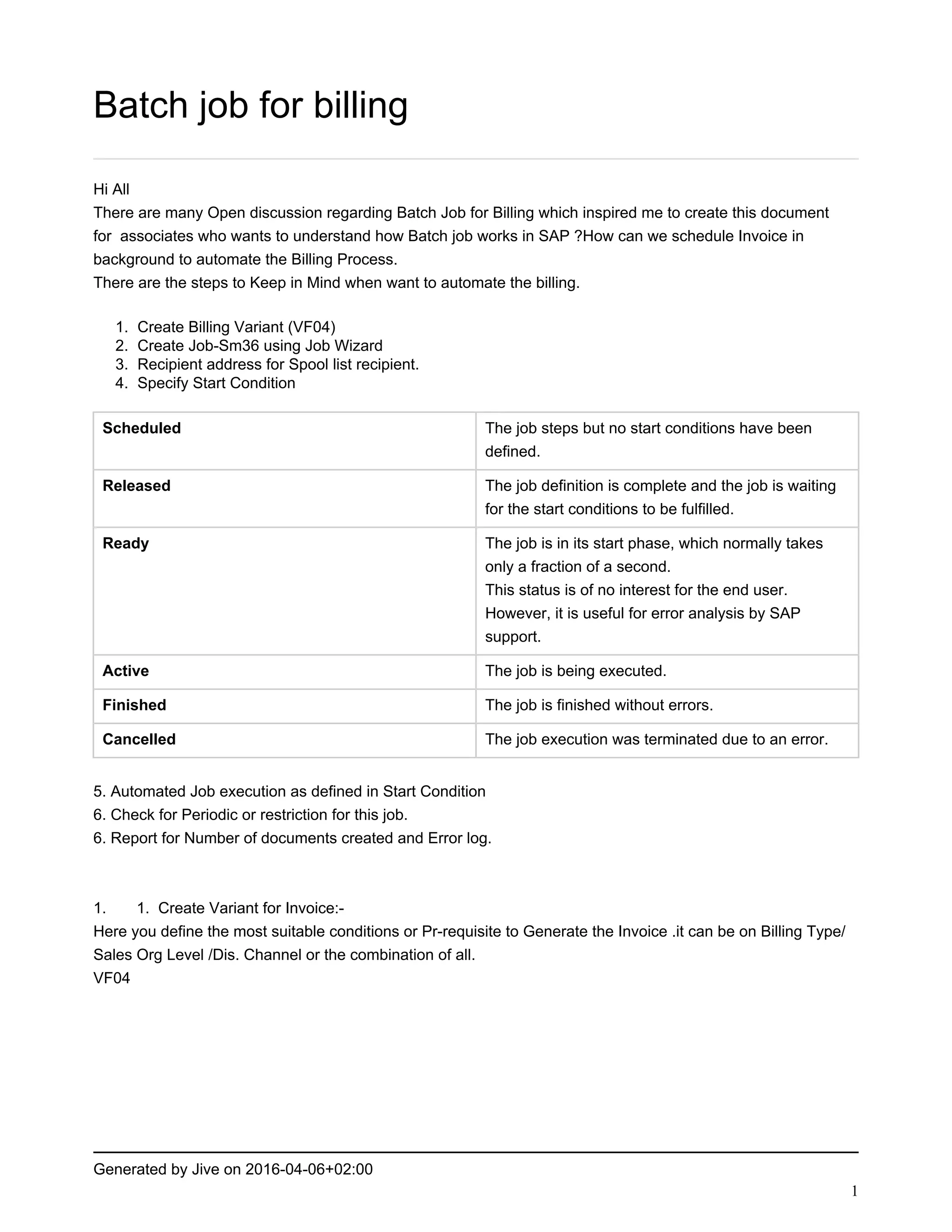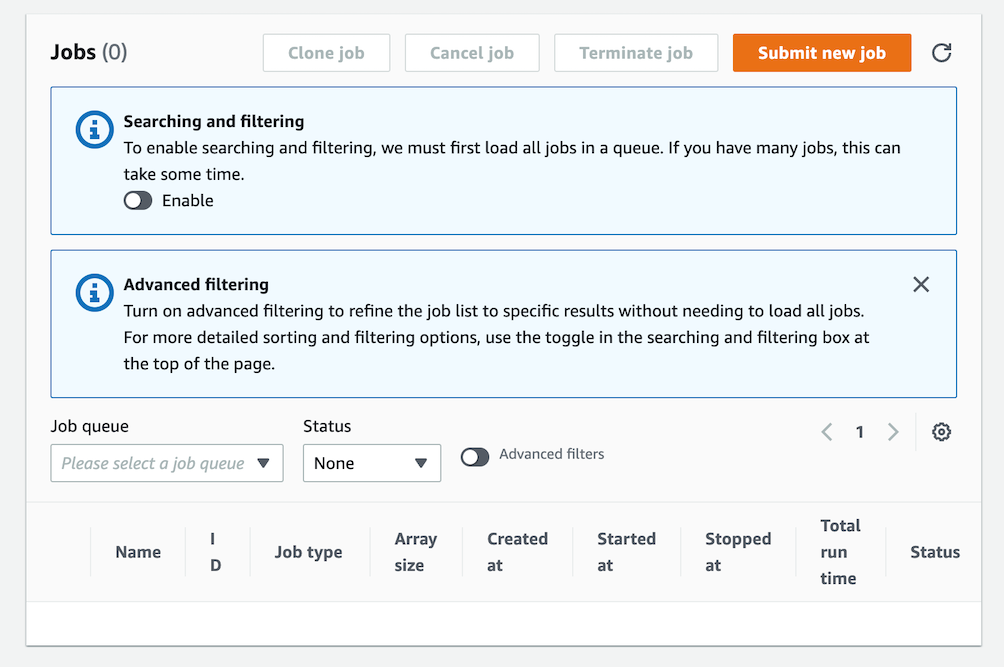RemoteIoT Batch Job Example: Revolutionizing Data Processing For Modern Businesses
Imagine this: you're managing a vast network of IoT devices spread across multiple locations, generating gigabytes of data every single day. How do you ensure that all this data is processed efficiently without overwhelming your system? Enter RemoteIoT batch job example – the ultimate solution for handling large-scale data processing tasks with ease.
In today's fast-paced digital world, businesses need robust tools to manage and analyze their data effectively. RemoteIoT batch job processing provides a scalable and reliable method to handle complex data tasks. By leveraging batch processing, companies can optimize resource utilization, reduce operational costs, and enhance overall performance. It’s like having a superpower for your data management needs.
This article dives deep into the world of RemoteIoT batch job examples, exploring how they work, their benefits, and real-world applications. Whether you're a tech enthusiast or a business owner looking to improve your data processing capabilities, this guide has got you covered. So, buckle up and let's embark on this exciting journey together!
Read also:Camilla Araujo Erome The Rise Of A Digital Sensation
Table of Contents
- What is RemoteIoT Batch Job?
- How Batch Processing Works
- Benefits of Using RemoteIoT Batch Job
- Real-World Examples of RemoteIoT Batch Jobs
- Tools and Technologies for RemoteIoT Batch Processing
- Common Use Cases for RemoteIoT Batch Jobs
- Optimizing RemoteIoT Batch Jobs for Performance
- Challenges in RemoteIoT Batch Job Implementation
- Future Trends in RemoteIoT Batch Processing
- Conclusion
What is RemoteIoT Batch Job?
A RemoteIoT batch job refers to the process of executing a series of tasks or operations on a large dataset in a non-interactive manner. Instead of processing data in real-time, batch jobs handle data in chunks, allowing for more efficient resource management. Think of it like baking a batch of cookies – you don’t bake one cookie at a time; you do them all together to save time and energy.
RemoteIoT batch jobs are particularly useful in scenarios where data processing requires significant computational power. By scheduling these jobs during off-peak hours, businesses can reduce server load and improve system performance. Plus, they can automate repetitive tasks, freeing up human resources for more critical activities.
So, why is RemoteIoT batch job processing gaining so much traction? Well, it’s all about scalability. As businesses grow and generate more data, traditional real-time processing methods may struggle to keep up. Batch processing offers a reliable alternative that can handle large volumes of data without breaking a sweat.
Why Choose RemoteIoT Batch Processing?
RemoteIoT batch processing stands out from other data processing methods due to its flexibility and efficiency. Here’s why it’s becoming a go-to solution for many organizations:
- Scalability: Easily handle growing data volumes without compromising performance.
- Cost-Effectiveness: Optimize resource usage and reduce operational expenses.
- Automation: Automate repetitive tasks to save time and improve accuracy.
- Reliability: Ensure consistent and accurate data processing results every time.
How Batch Processing Works
Batch processing follows a simple yet powerful workflow. First, data is collected and stored in a designated location. Then, a batch job is scheduled to process this data at a specific time or interval. During execution, the job reads the data, performs the necessary operations, and stores the results in a target location.
This method is especially useful when dealing with tasks that don’t require immediate results. For instance, generating daily sales reports or analyzing sensor data from IoT devices can be done efficiently using batch processing. It’s like having a personal assistant who takes care of all your data-related chores while you focus on other important things.
Read also:Gary Brecka Scam The Untold Story You Need To Know
Key Components of Batch Processing
To implement RemoteIoT batch jobs effectively, you need to understand its key components:
- Input Data: The raw data that needs to be processed.
- Batch Job: The set of instructions or operations to be performed on the data.
- Scheduler: The tool or system that manages and executes batch jobs.
- Output Data: The processed data that results from the batch job execution.
Benefits of Using RemoteIoT Batch Job
Adopting RemoteIoT batch job processing offers numerous advantages for businesses of all sizes. Let’s take a closer look at some of the most significant benefits:
1. Improved Efficiency: By processing data in batches, you can significantly reduce processing time and resource consumption. It’s like running a marathon instead of sprinting – you conserve energy and maintain a steady pace.
2. Enhanced Scalability: As your data grows, batch processing allows you to scale your operations seamlessly without overhauling your entire system. This flexibility ensures that your business can adapt to changing demands effortlessly.
3. Cost Savings: Automating data processing tasks with batch jobs reduces the need for manual intervention, leading to substantial cost savings. Plus, by scheduling jobs during off-peak hours, you can further optimize your resource usage and lower operational expenses.
Additional Perks of RemoteIoT Batch Processing
- Increased Accuracy: Automated batch jobs minimize the risk of human error, ensuring more accurate results.
- Improved Resource Management: Efficiently allocate resources to handle large-scale data processing tasks.
- Flexibility: Easily adapt to changing business requirements by modifying batch job parameters.
Real-World Examples of RemoteIoT Batch Jobs
Let’s explore some real-world scenarios where RemoteIoT batch jobs have made a significant impact:
1. Smart Agriculture: Farmers use IoT sensors to monitor soil moisture, temperature, and other environmental factors. Batch jobs process this data to generate actionable insights, helping farmers optimize crop yields and reduce resource waste.
2. Healthcare: Hospitals leverage IoT devices to collect patient data, such as heart rate and blood pressure. Batch jobs analyze this data to identify potential health issues and alert medical staff accordingly.
3. Supply Chain Management: Companies use IoT sensors to track inventory levels and shipment status. Batch jobs process this data to optimize logistics operations and improve delivery times.
Success Stories
Many organizations have achieved remarkable results by implementing RemoteIoT batch job processing. For example, a leading manufacturing company reduced its data processing time by 40% while cutting costs by 30%. Another case involves a retail giant that improved its inventory management system, resulting in a 25% increase in sales.
Tools and Technologies for RemoteIoT Batch Processing
Several tools and technologies are available to facilitate RemoteIoT batch job processing. Some of the most popular ones include:
- AWS Batch: A fully managed service that makes it easy to run batch computing workloads on the AWS cloud.
- Apache Hadoop: An open-source framework for distributed storage and processing of large datasets.
- Google Cloud Dataflow: A unified processing service for batch and streaming data.
- Microsoft Azure Batch: A service for running large-scale parallel and batch computing applications in the cloud.
Choosing the right tool depends on your specific requirements, budget, and technical expertise. It’s essential to evaluate each option carefully to ensure it aligns with your business goals.
Key Features to Look For
- Scalability: Ensure the tool can handle growing data volumes without compromising performance.
- Automation: Look for tools that offer robust automation capabilities to streamline your batch processing workflows.
- Integration: Choose a tool that integrates seamlessly with your existing systems and infrastructure.
Common Use Cases for RemoteIoT Batch Jobs
RemoteIoT batch jobs find applications in various industries, including:
1. Manufacturing: Analyze production data to identify bottlenecks and optimize operations.
2. Transportation: Process GPS data to improve fleet management and route planning.
3. Energy: Monitor energy consumption patterns to enhance efficiency and reduce costs.
Industry-Specific Applications
- Finance: Perform risk analysis and fraud detection using batch processing techniques.
- Retail: Analyze customer behavior data to personalize marketing campaigns and improve sales.
- Telecommunications: Process network usage data to optimize infrastructure and enhance user experience.
Optimizing RemoteIoT Batch Jobs for Performance
To get the most out of your RemoteIoT batch jobs, consider the following optimization strategies:
1. Parallel Processing: Divide large datasets into smaller chunks and process them simultaneously to improve speed and efficiency.
2. Resource Allocation: Allocate resources based on job priority and complexity to ensure optimal performance.
3. Monitoring and Logging: Implement robust monitoring and logging mechanisms to track job progress and identify potential issues.
Best Practices for Optimization
- Regular Maintenance: Keep your systems and tools up to date to avoid performance degradation.
- Load Balancing: Distribute workloads evenly across servers to prevent bottlenecks.
- Testing: Conduct regular testing to ensure your batch jobs perform as expected.
Challenges in RemoteIoT Batch Job Implementation
While RemoteIoT batch job processing offers numerous benefits, it’s not without its challenges. Some common issues include:
1. Complexity: Setting up and managing batch jobs can be complex, especially for organizations with limited technical expertise.
2. Scalability: Handling growing data volumes requires robust infrastructure and tools, which can be costly.
3. Security: Ensuring data security and compliance with industry regulations is crucial when processing sensitive information.
Overcoming Challenges
- Training: Invest in training programs to upskill your team and improve their technical capabilities.
- Cloud Solutions: Leverage cloud-based tools and services to scale your operations cost-effectively.
- Encryption: Implement strong encryption protocols to safeguard your data against unauthorized access.
Future Trends in RemoteIoT Batch Processing
The future of RemoteIoT batch processing looks promising, with several exciting trends on the horizon:
1. Artificial Intelligence: AI-driven batch processing tools will enable smarter decision-making and enhanced automation.
2. Edge Computing: Processing data closer to the source will reduce latency and improve real-time capabilities.
3. Quantum Computing: As quantum computing becomes more mainstream, it will revolutionize batch processing by solving complex problems at unprecedented speeds.
Staying Ahead of the Curve
To remain competitive, businesses must embrace these emerging trends and integrate them into their batch processing workflows. By doing so, they can unlock new opportunities for growth and innovation while maintaining a competitive edge in the market.
Conclusion
RemoteIoT batch job processing is a game-changer for businesses looking to streamline their data management processes. With its ability to handle large-scale data tasks efficiently and cost-effectively, it’s no wonder that more and more organizations are adopting this technology. By understanding its benefits, challenges, and future trends, you can make informed decisions to enhance your data processing capabilities.
So, what are you waiting for? Dive into the world of RemoteIoT batch job processing and unlock the
Article Recommendations


